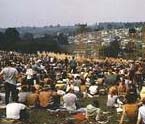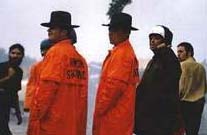Location:Woodstock, Vermont
Background: In the summer of 1970, promoters Lew Workman and
Brian Wilkie hatched a scheme for a four-day outdoor concert on a farm
outside the small town of Woodstock, Vermont. The promoters hoped to
recapture the spirit of the original Woodstock Festival, which had taken
place a year earlier in upstate New York. They also hoped that their
concert, dubbed Woodstock II, would helped erase bad memories left over
from the December, 1969, Altamont Concert in California, where a fan had
been stabbed to death while the Rolling Stones were playing onstage.
Workman and Wilkie were able to lure a number of big acts to the event,
including King Crimson, Iron Butterfly and Mountain.

Incident: On the second night of the concert, Teddy Desilets, a member of the Hell's Angels motorcycle gang, arrived at the Emergency Room of the Woodstock Hospital with a badly-mangled right hand. Desilets had been attending Woodstock II and was apparently attacked by a crazed man while relieving himself in the woods. The twenty-six-year-old Desilets, who had lost his thumb and parts of two fingers in the attack, underwent surgery and was admitted to intensive care.
The following night, police were summoned to the hospital with reports of a deranged man terrorizing the patients and staff. When police arrived, they found Desilets in a catatonic state, blood streaming from his mouth. Desilets attacked the police and, despite being shot numerous times, escaped into the night. All told, eleven patients and two cops were bitten; the most serious of the injured had almost his entire shoulder chewed off.
At first, police and doctors believed that Desilets' state was due to a reaction to hallucinogenic drugs. But after several more people arrived at the hospital from the concert with bite injuries, the FVZA was notified. The Agency instructed hospital staff to vaccinate and quarantine any victims until they arrived. Unfortunately, hospital staff discovered that it had no vaccine on hand, and with several of the patients bitten by Desilets turning into zombies, they were soon overwhelmed. The panicked staff moved as many of the sick out of the hospital as they could, and then abandoned the building.
Investigation: Within two hours of being notified, an FVZA team
from Boston arrived in Vermont, took stock of the situation and quickly
called for reinforcements from the New York office. With the help of
the Vermont National Guard, the Boston team secured the hospital,
administered vaccine to the recently wounded, and destroyed a total of
22 zombies inside the building. The search-and-destroy mission was
particularly hazardous, as one of the zombies had chewed through an
electrical cable, cutting power to the building and leaving it mostly
dark.
 The
New York team arrived at the concert via a police escort just as
Crosby, Still, Nash and Young were about to go on. The Agency apprised
concert organizers of the situation and asked them to call off the show.
When the huge crowd was told of the concert's cancellation, they
rioted, turning over police cars and lighting the stage on fire.
Several of the bands, including CSN&Y, had to be helicoptered out of
the area. Fortunately, a large contingent of National Guard troops
arrived from Massachusetts and restored order.
The
New York team arrived at the concert via a police escort just as
Crosby, Still, Nash and Young were about to go on. The Agency apprised
concert organizers of the situation and asked them to call off the show.
When the huge crowd was told of the concert's cancellation, they
rioted, turning over police cars and lighting the stage on fire.
Several of the bands, including CSN&Y, had to be helicoptered out of
the area. Fortunately, a large contingent of National Guard troops
arrived from Massachusetts and restored order.
National Guard and state police under the supervision of FVZA agents organized the evacuation of the area, during which 17 zombies were encountered and destroyed. Over the course of the next day, another 23 zombies were destroyed in the woods surrounding the farm. Among the dead zombies: Teddy Desilets, who had managed to stagger back to the concert despite having 15 bullets in him; and John Robie, owner of a neighboring farm.
Post Mortems: The zombie outbreak that started at Woodstock II
took many weeks to fully contain. Several zombies managed to stray into
neighboring towns, and one infected motorcycle gang went on a rampage
across several states before they were trapped in an abandoned barn in
Indiana and destroyed.

The source of the zombie attacks was traced back to the farmer John Robie. Robie had been cleaning the henhouse at his farm when he was apparently bitten by an infected rat. After his transformation was complete, he made his way to the concert site and a veritable zombie smorgasbord.
Comments from Dr. Pecos: By the mid-Twentieth Century, zombie
attacks were very rare.
For the rest of the summer, Vermont was a state under quarantine. An
atmosphere of fear and paranoia reigned: most Vermonters stayed in their
homes, and several innocent people were shot and killed when they were
mistaken for zombies. Thousands of livestock had to be destroyed after
several cows were discovered to be carrying the virus. By the time the
outbreak was fully contained, 137 people had been bitten; of those, 79
were transformed and eventually destroyed. Concert promoters Workman
and Wilkie were ruined.
Many hospitals stopped carrying the vaccine, and few if any doctors had any experience dealing with victims. This ignorance, coupled with the large crowd at Woodstock II, combined to create the worst single wave of zombie attacks in U.S. history. Woodstock II, which had been organized to promote peace and love, would forever be known as "Deadstock."
 |
| A crowd of over 200,000 attended Woodstock II |
Incident: On the second night of the concert, Teddy Desilets, a member of the Hell's Angels motorcycle gang, arrived at the Emergency Room of the Woodstock Hospital with a badly-mangled right hand. Desilets had been attending Woodstock II and was apparently attacked by a crazed man while relieving himself in the woods. The twenty-six-year-old Desilets, who had lost his thumb and parts of two fingers in the attack, underwent surgery and was admitted to intensive care.
The following night, police were summoned to the hospital with reports of a deranged man terrorizing the patients and staff. When police arrived, they found Desilets in a catatonic state, blood streaming from his mouth. Desilets attacked the police and, despite being shot numerous times, escaped into the night. All told, eleven patients and two cops were bitten; the most serious of the injured had almost his entire shoulder chewed off.
At first, police and doctors believed that Desilets' state was due to a reaction to hallucinogenic drugs. But after several more people arrived at the hospital from the concert with bite injuries, the FVZA was notified. The Agency instructed hospital staff to vaccinate and quarantine any victims until they arrived. Unfortunately, hospital staff discovered that it had no vaccine on hand, and with several of the patients bitten by Desilets turning into zombies, they were soon overwhelmed. The panicked staff moved as many of the sick out of the hospital as they could, and then abandoned the building.
 |
| State Police shoo away stragglers the morning after the cancellation |
National Guard and state police under the supervision of FVZA agents organized the evacuation of the area, during which 17 zombies were encountered and destroyed. Over the course of the next day, another 23 zombies were destroyed in the woods surrounding the farm. Among the dead zombies: Teddy Desilets, who had managed to stagger back to the concert despite having 15 bullets in him; and John Robie, owner of a neighboring farm.
 |
| John Robie's farm |
The source of the zombie attacks was traced back to the farmer John Robie. Robie had been cleaning the henhouse at his farm when he was apparently bitten by an infected rat. After his transformation was complete, he made his way to the concert site and a veritable zombie smorgasbord.
 |
| Macabre souvenir: a ticket from the festival |
Many hospitals stopped carrying the vaccine, and few if any doctors had any experience dealing with victims. This ignorance, coupled with the large crowd at Woodstock II, combined to create the worst single wave of zombie attacks in U.S. history. Woodstock II, which had been organized to promote peace and love, would forever be known as "Deadstock."

No comments:
Post a Comment